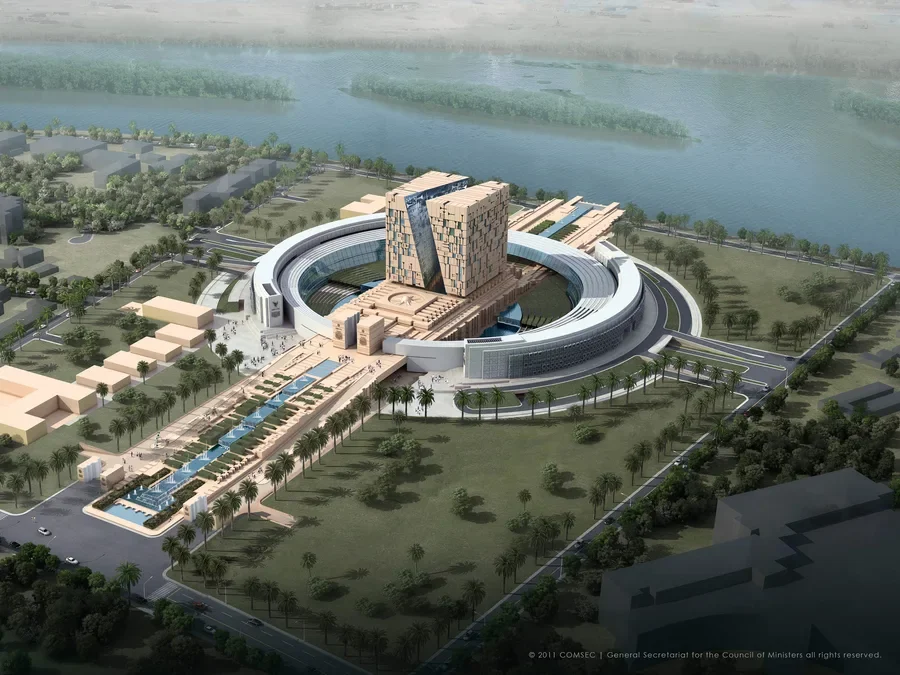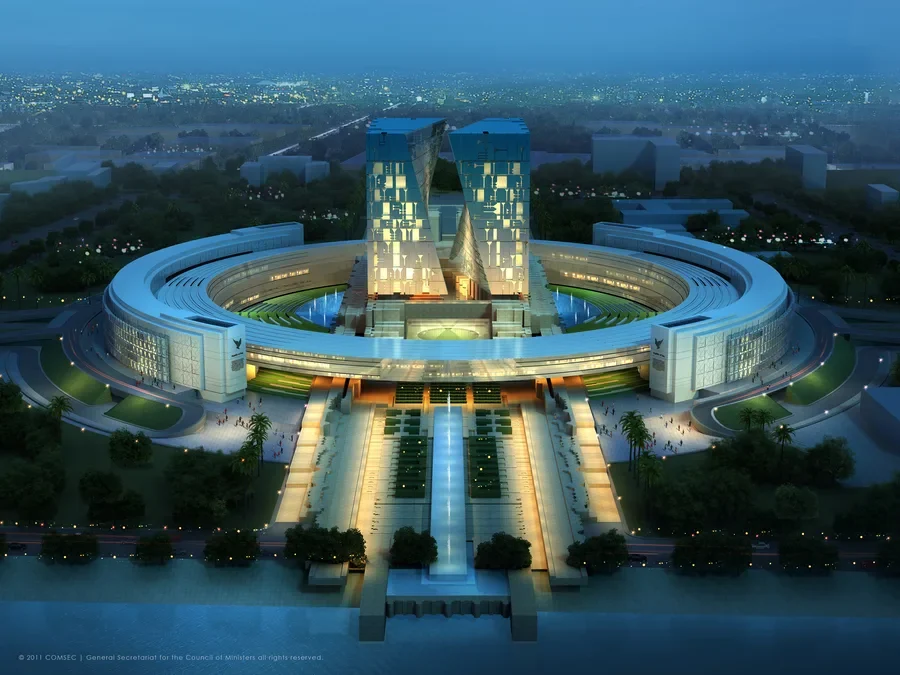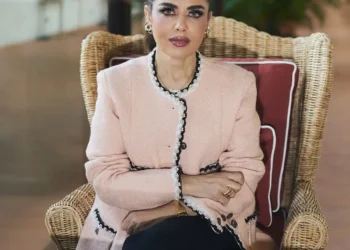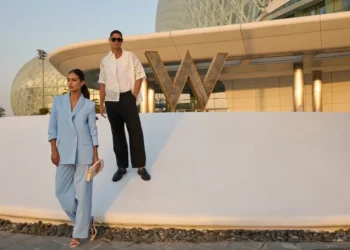CAN YOU WALK US THROUGH YOUR PERSONAL JOURNEY INTO ARCHITECTURE, HIGHLIGHTING KEY MOMENTS THAT SHAPED YOUR DESIGN PHILOSOPHY AND YOUR UNDERSTANDING OF IRAQ’S UNIQUE ARCHITECTURAL IDENTITY?
My passion for architecture began at an early age. I was always fascinated by the deep connection between place and memory. My journey passed through multiple milestones that profoundly shaped my architectural vision, starting with my academic studies at the Department of Architecture at the University of Baghdad, where I had the privilege of learning under some of Iraq’s most distinguished architects. This was followed by professional experiences across diverse environments, both within Iraq and internationally. Over time, I came to firmly believe that architecture is not merely a technical practice, but a profound cultural expression of the human condition, history, and surroundings. This belief became the foundation of my design philosophy.
IN YOUR EXPERIENCE, HOW DOES IRAQI CULTURAL HERITAGE INFLUENCE YOUR APPROACH TO CONTEMPORARY ARCHITECTURE, AND WHAT ELEMENTS DO YOU BELIEVE SHOULD BE PRESERVED OR REINTERPRETED IN MODERN DESIGNS?
Iraqi cultural heritage, to me, is not merely a collection of historical forms or decorative motifs-it is an intangible reservoir of meanings, symbols, and worldviews shaped over thousands of years. What inspires me most are not the physical remnants, but the silent wisdom embedded within them: the way space was perceived, how the sacred and the ordinary were woven together, how the built environment mirrored a deeper civilizational consciousness. In my architectural approach, I engage with this heritage not as a source of forms to be imitated, but as a profound cultural memory to be reawakened and reinterpreted. I seek to translate these intangible legacies into contemporary expressions-ones that speak to the present without severing ties with the past. Architecture, in this sense, becomes a dialogue across time: critically aware, emotionally rooted, and spiritually resonant.
CONSIDERING IRAQ’S COMPLEX HISTORY AND DIVERSE CULTURAL LANDSCAPE, HOW DO YOU NAVIGATE INTEGRATING TRADITIONAL ARCHITECTURAL FEATURES WITH MODERN CONSTRUCTION TECHNIQUES AND MATERIALS IN YOUR PROJECTS?
I see the fusion of traditional elements and modern technologies not as a challenge, but as an opportunity to create an architectural language that is both contemporary and rooted in its local context. In my work, I employ modern materials and advanced technologies to achieve efficiency and performance without compromising the local spirit. For example, I have reimagined the use of brick-deeply embedded in Iraq’s architectural heritage-as a modern facade element. This is done through careful manipulation of light and shadow, thoughtful proportionality, and the revival of traditional craft detailing within contemporary construction systems. In doing so, architecture becomes a dialogue between past and present, not merely imitation or rupture.
WHAT ARE SOME OF THE MOST SIGNIFICANT PROJECTS YOU’VE WORKED ON WITHIN IRAQ, AND COULD YOU SHARE THE CHALLENGES YOU FACED DURING THEIR DEVELOPMENT, PARTICULARLY IN TERMS OF LOGISTICAL, POLITICAL, OR SOCIETAL FACTORS?
I’ve had the honour of contributing to several transformative projects across Iraq, including the General Secretariat of the Council of Ministers building, the terminal building of Karbala International Airport, and the American University in Banghdad. I also led the urban design for Al- Rafeel District and am currently working on the new economic capital adjacent to Baghdad-an ambitious step toward sustainable urban development. The challenges are considerable: from infrastructural fragility and bureaucratic complexity to financial uncertainty. Yet what sustains this work is a deep conviction that architecture can he a catalyst for change, and a commitment to resilience in the face of adversity.
SUSTAINABILITY HAS BECOME A GLOBAL PRIORITY-HOW DO YOU INCORPORATE SUSTAINABLE PRACTICES AND ENVIRONMENTALLY FRIENDLY SOLUTIONS INTO YOUR DESIGNS, ESPECIALLY GIVEN THE SPECIFIC CLIMATIC AND RESOURCE CONDITIONS IN IRAQ?
Sustainability, in my work, is not optional-it’s foundational. Given Iraq’s extreme climate and limited resources, designing in harmony with the environment is a necessity. I prioritize passive strategies such as optimal orientation, natural ventilation, and the use of thermally efficient local materials like Iraqi brick. But the real challenge lies not in the design itself, but in implementing sustainability on the ground. The higher initial costs of sustainable technologies and materials often clash with short-term budget mindsets and fragmented project delivery systems. Despite this, I remain committed to embedding sustainability from the earliest design stages-because in Iraq, the cost of inaction will always be far greater than the cost of doing it right.
INNOVATION OFTEN INVOLVES PUSHING BOUNDARIES-CAN YOU DISCUSS A PROJECT WHERE YOU EXPERIMENTED WITH NEW ARCHITECTURAL IDEAS OR TECHNOLOGIES, AND WHAT IMPACT YOU HOPE IT WILL HAVE ON THE IRAQI ARCHITECTURAL SCENE?
Innovation, to me, means rethinking the fundamentals-especially in a place like Iraq, where urban growth often follows outdated patterns. One of the most significant conceptual breakthroughs in my work is what I call The Third Urban Fabric, developed as part of the masterplan for Baghdad’s new economic metropolis. This concept reimagines the relationship between the city and nature by introducing a hybrid fabric-neither purely rural nor strictly urban. It offers an alternative to traditional urban sprawl, which has long fragmented Iraq’s cities and landscapes. Instead, we propose a new typology where green meadows, productive land, and human-scale urbanity are seamlessly interwoven to create a resilient, sustainable, and emotionally enriching environment. I believe this approach could mark a turning point in Iraqi urbanism-shifting the focus from expansion to integration, and from form to meaning.
THE ARCHITECTURAL INDUSTRY IN IRAQ HAS FACED NUMEROUS OBSTACLES OVER RECENT DECADES-WHAT DO YOU SEE AS THE MAIN BARRIERS TO PROGRESS, AND HOW DO YOU BELIEVE YOUNG ARCHITECTS CAN OVERCOME THEM?
Architecture in Iraq faces a range of structural challenges, foremost among them being the absence of a clear national vision for urban development, lack of institutional coordination, and outdated legislation governing the profession. Added to this are deteriorating infrastructures- particularly road and transport networks-and a complex bureaucratic environment that hinders workflow and slows progress. Despite these hurdles, I firmly believe that Iraqi youth possess remarkable creative potential. With the right support systems and opportunities for experimentation, they can become key drivers of architectural and environmental transformation.
GIVEN THE RAPID URBANISATION AND INFRASTRUCTURAL DEVELOPMENT IN IRAQI CITIES, HOW DO YOU ENVISION THE FUTURE SKYLINE OF BAGHDAD AND OTHER MAJOR URBAN CENTERS EVOLVING IN THE COMING DECADES?
I envision more humane, flexible Iraqi cities that prioritize pedestrians and communities over cars, based on the “15-minute city” concept-where all essential services like education, healthcare, retail, and leisure are accessible within a 15-minute walk or bike ride. The future of Iraq’s cities lies in integrated urban systems with smart, sustainable infrastructure that utilizes clean energy, efficient resource management, and inclusive public spaces. I place high value on vibrant public realms, urban gardens, and green corridors that foster cultural and social interaction within healthy, safe environments. Baghdad in particular, with its historical depth and cultural richness, can reclaim its urban brilliance through a comprehensive planning vision-one that respects its legacy, redistributes urban functions equitably, and reconnects its districts via effective public transportation and multifunctional urban hubs. Building future cities in Iraq requires an ambitious national vision, institutional synergy, and genuine partnerships between the public and private sectors to create contemporary urban environments centered on people and built for future generations.
TECHNOLOGY PLAYS A SIGNIFICANT ROLE IN MODERN ARCHITECTURE-HOW HAVE DIGITAL TOOLS, 3D MODELING, OR OTHER INNOVATIONS CHANGED YOUR WORKFLOW AND DESIGN PROCESS?
Technology has fundamentally transformed the way I work. Architecture is no longer confined to drawings or theoretical concepts-it has become a fully integrated process supported by advanced digital tools that enable spatial exploration, environmental performance analysis, and real-time design interaction. I use software such as Revit, Rhino, Grasshopper, Enscape, and Lumion on a daily basis, along with environmental analysis tools like Ladybug and ClimateStudio. These tools allow precise design modeling and performance simulation for lighting, ventilation, and energy consumption-informing better decision-making. Modern construction techniques- such as digital structural modeling, prefabrication, and 3D printing-have further enhanced precision, reduced material waste, and increased on-site efficiency. Moreover, I increasingly adopt eco-friendly materials such as advanced thermal insulation, low-emission concrete, and smart glass, aligning with the global shift toward green buildings. Most importantly, technology has become a vital medium for collaboration- enabling interactive design reviews with teams and clients, streamlining communication, and reducing misunderstandings. It has evolved from a support tool to a core pillar of design and urban development.
CULTURAL AND SOCIETAL INFLUENCES ARE CENTRAL TO YOUR WORK-HOW DO YOU ENSURE THAT YOUR DESIGNS RESONATE WITH LOCAL COMMUNITIES AND PROMOTE A SENSE OF IDENTITY AND BELONGING?
Every project I undertake begins with a deep, holistic understanding of the local context-not just in spatial and urban terms, but in social, cultural, and economic dimensions. Whether in Iraq or abroad, I give great weight to everyday life patterns, social behaviors, and community dynamics. I translate these insights into design solutions that reflect local lifestyles, circulation patterns, and material choices. For me, architecture is not simply a response to functional needs-it is a means of expressing identity and fostering a sense of belonging. Successful architecture, in my view, is that which people recognize themselves in-it offers them dignity, comfort, and aligns with their aspirations while remaining grounded in their lived reality. It becomes both a reflection of its environment and a contributor to the richness of the urban and social fabric.
LOOKING FORWARD, WHAT ARE YOUR PERSONAL AMBITIONS AS AN ARCHITECT AND YOUR HOPES FOR THE IRAQI ARCHITECTURAL COMMUNITY AT LARGE? ARE THERE SPECIFIC PROJECTS OR INITIATIVES YOU AIM TO PURSUE?
Looking ahead, my greatest ambition is to help inspire a new generation of Iraqi architects. I believe deeply in the potential of our young talents, and I intend to dedicate part of my time to teaching and mentoring in architectural schools. It’s not only about sharing knowledge-it’s about nurturing a culture of critical thinking, creativity, and responsibility toward the built environment.
FINALLY, WHAT ADVICE WOULD YOU GIVE TO ASPIRING IRAQI ARCHITECTS WHO WISH TO CONTRIBUTE MEANINGFULLY TO THEIR COUNTRY’S DEVELOPMENT AND LEAVE A LASTING LEGACY IN THE BUILT ENVIRONMENT?
My advice is to always seek meaning before form. Strive to understand the intellectual and human foundations of design rather than merely following stylistic trends. Great architecture is not built on imitation, but on independent critical thinking grounded in context, reality, and vision. Architecture is not just a profession-it is an ethical and cultural responsibility that requires awareness of the architect’s role in shaping lives and collective memory. Iraq today urgently needs a generation of thoughtful architects who can help rebuild not only its infrastructure, but also revive its civilizational values and cultural identity. To every ambitious architect I say: don’t wait for the opportunity-create it. Be the bridge between what we once were and what we can become.

































